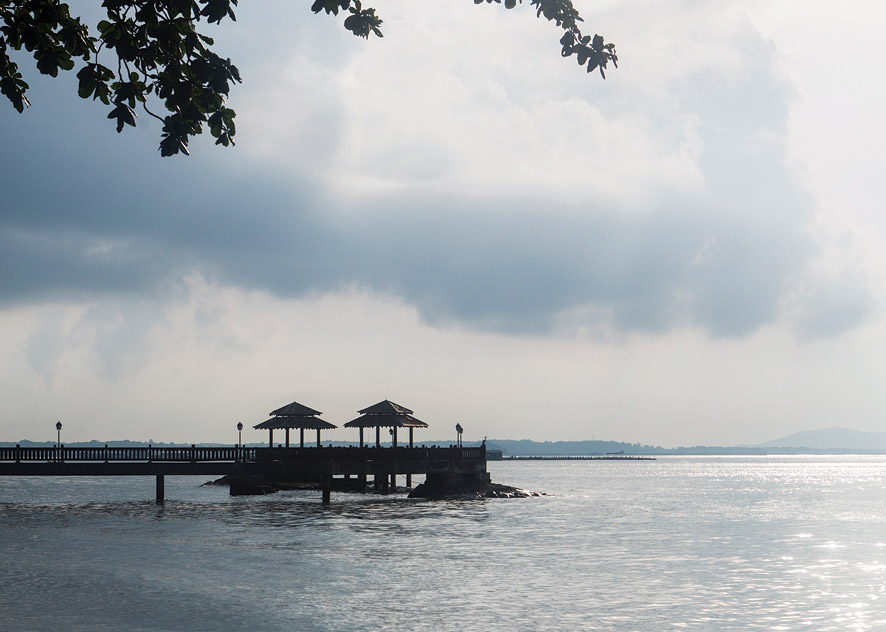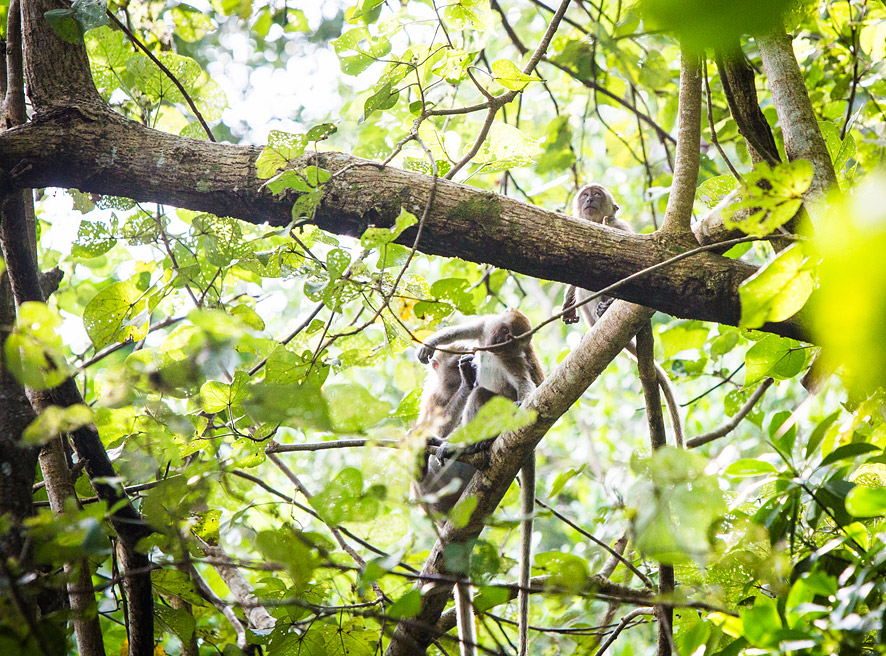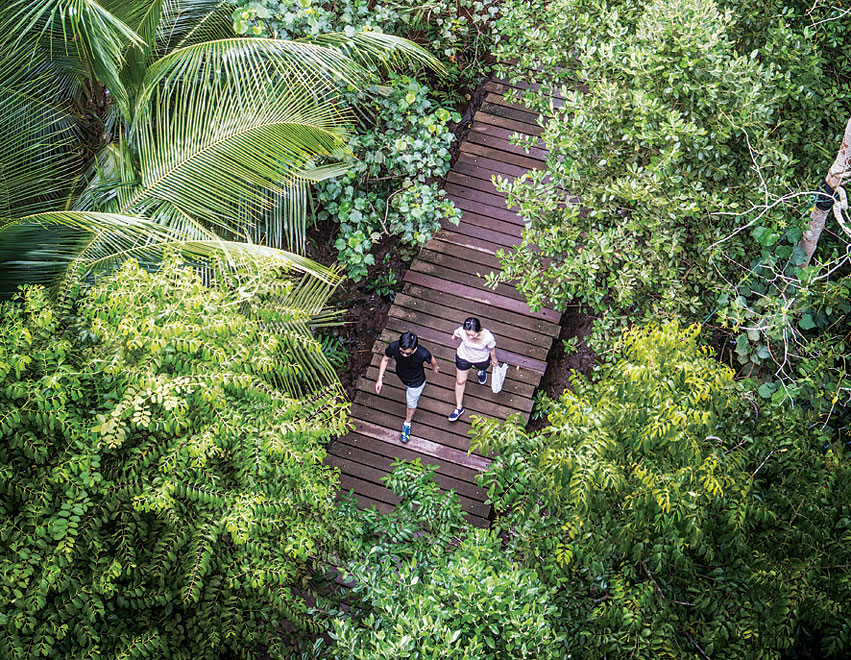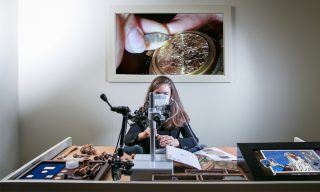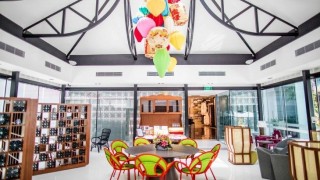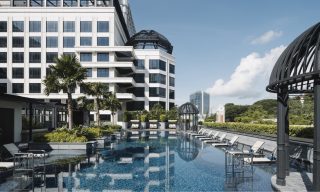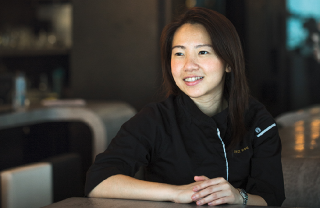For now, village life here and at Kampong Buangkok, the last surviving kampong on the Singapore mainland, continues. Buangkok, though, feels like a defiant bubble without context to its environs—the leafy 27-house settlement is encircled by gleaming apartment towers. By contrast, the homes on Ubin look and feel like they belong, as though they are an organic part of the setting.
There is also nuance to the residents on Ubin; they’re not just holdouts refusing to be cooped up in mainland flats. Outside a boxy blue house near Republic Polytechnic’s kayak facility at Ubin Quarry, I meet a sturdy, wistful-looking 24-year-old Filipino with a placid face and yellow rubber boots. Jason Panteleon, originally from Ilocos, has been working as a landscaper on Ubin for three years, planting trees, cutting foliage, and maintaining byways for the National Parks Board. He shares the house with Chito Castillio, a sinewy 28-year-old from Manila who works the same detail.
“Life here is too quiet, we are so bored,” Panteleon says. “But there are good things, like free vegetables. It’s not difficult to live here, there are no troubles, nobody quarrelling, but getting here and getting away is difficult.” He then surprises me with an invitation to join him for lunch; a pot of papaya and pork is bubbling in the kitchen. Having just eaten, I decline, but I’m touched by his generosity of spirit.
A few minutes away by bike, near a house numbered 36-1, I spot a lean old Chinese uncle sorting through a mound of junk. In the foreground, a stocky young man with a ponytail is talking on his mobile phone. Intrigued, I wait for the conversation to end and introduce myself. Arif Ayab explains that he’s the manager of The Artists Village (TAV), a contemporary art group in Singapore that runs a residency program at the house. The lean old-timer is the house’s owner and the uncle of TAV director Jeremy Hiah. He’s also a karung guni, a collector of various pieces of trash or treasure, depending on how you look at it—hence the junk pile. TAV runs one-month residencies here three times a year, two artists at a time, fully funded by Singapore’s National Arts Council.
Ayab offers me a glass of lemon juice with honey and ice, and introduces me to Hiah and the artists currently there—Jacquelyn Soo, a Singaporean conceptual artist, and Wang Chuyu, a performance artist from China. They usher me inside to eat some boiled jackfruit seeds, their flavor and texture taking me back to the boiled chestnuts of my childhood in England. Again, impromptu hospitality; I could get used to this. “Here in this natural environment, away from the city, you have such a different perspective, and as an artist you need that,” Soo says. “This is probably the most unique residency I have done.”
“This place has everything,” adds Hiah. “We have solar panels on the roof, and papaya, jackfruit, mango, durian, lime, coconut, all here.” When I ask him whether he’s worried that Ubin will be developed, he takes my hand, leads me outside, and kicks the ground at our feet. “This is the second largest island in Singapore, larger than Sentosa, so why haven’t they built here?”
I shrug.
“The granite. It’s very difficult to build foundations on granite.”
It’s jarring to return to civilization after a day on Ubin. On the taxi ride back to my apartment in east Singapore, I can’t help but snicker at the names of the condominium developments we pass, all trumpeting their apparent connection to nature—The Glades, Seawind, Silversea. It’s especially ridiculous given that I had just experienced the real deal a few kilometers away. Then a worrying thought flashes across my mind. How long before some diabolical developer names his next mainland project Ubin South?
THE DETAILS
Getting There
Bumboats operate from the Changi Point Ferry Terminal from about 6 a.m. until about 8 p.m., and charge S$2.50 (US$2) per person each way for the 10-minute passage to Ubin. Boats can also be chartered for about US$24 per trip.
Where to Stay
Pulau Ubin makes a great day trip; for those wishing to spend a night, options—apart from camping—are limited to the Celestial Ubin Beach Resort (65/ 6542-9749; villas from US$240), whose basic but overpriced cottages (avoid the standard rooms) are just a short stroll from the Ubin jetty.
Getting Around
Bicycles, readily available for rent in Ubin Village, are the most efficient, most popular, and—at about US$8 per day—most cost-effective way to tour the isle. Minibus taxis are also available.
Practicalities
Be sure to pack insect repellant, as Ubin’s mosquitoes have a fierce repute. For other tips, visit pulauubin.com.sg.
This article originally appeared in the December 2013/January 2014 print issue of DestinAsian magazine (“An Island Apart”)

